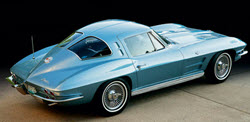1975 Corvette Sting Ray

The base 1975 Corvette Sting Ray had a 350 cu. in. 165 hp engine and wide ratio four speed manual transmission. This can be compared to the base 1971 Corvette Sting Ray 350 cu. in. engine which had a capacity of 300 hp. There are several contributing factors behind this harsh drop in horsepower. One of them is the introduction of the standardized horsepower rating system in 1972. This hp rating system strived to better reflect real world conditions and many engines dropped dramatically with the new system. The Corvette LS5 454 cu. in. engine did for instance go from 365 hp in 1971 to 270 hp in 1972.
The other factor is stricter environmental laws and this factor was not a question of how to label engines; it had an actual impact on engine performance. The 1970 Corvette Sting Ray was the last chance to get a Corvette with a high compression engine. Finding gasoline stations offering high octane fuel had become increasingly difficult and new smog laws finally made Chevrolet give up the “big block” engines. Unleaded fuel was the way of the future and this change would have a momentous impact on overall engine performance – not only for Corvette. In 1971, before the new hp rating system had came into effect, the hp rating for the LS5 454 cu. in. engine dropped from 390 hp to 365 hp.
For the first time in a decade, there was only one engine displacement available for the Corvette buyers. The base 1975 Corvette Sting Ray came with a 350 cu. in. 165 hp engine and the only available option to this standard engine was the L82 350 cu. in. 205hp engine which cost $336. Only slightly over 6 percent of the buyers were interested in the alternative motor and the 205hp engine was only installed in 2,372 1975 Corvette Sting Ray cars. The 1975 Corvette Sting Ray was the first Corvette equipped with a catalytic converter and only a single converter could be used. This meant the end for the true dual exhaust system.
In the 1975 Corvette Sting Ray, the old transistorized ignition system had been replaced by a high energy ignition system which had many advantages. The tachometers was now electronically connected instead of being mechanical and connected via cable. Another interesting change was the fuel tank which had an internal bladder.
The total production figure for the 1975 Corvette Sting Ray landed on 38,465, of which nearly 90 percent were coupes. Banning convertibles all together due to safety concerns were being discussed in the United States and many people feared that the 1975 Corvette Sting Ray would mark the end of the Corvette Sting Ray convertibles. The anti-convertible legislation never became a reality, but Chevrolet nonetheless cancelled the production of Corvette Sting Ray cabriolets in 1976. Many people bought the 1975 Corvette Sting Ray cabriolet as an investment, hoping that it would become a valuable collectors car in the future due to the predicted cabriolet ban. A new Corvette Sting Ray cabriolet did however appear on the scene ten years later, in 1986.



